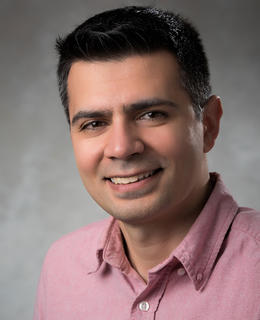
Dr. Amin Komeili
Positions
Associate Professor
Schulich School of Engineering, Department of Biomedical Engineering
Associate Professor
Schulich School of Engineering, Department of Mechanical and Manufacturing Engineering
Adjunct Associate Professor
Faculty of Kinesiology
Full Member
McCaig Institute for Bone and Joint Health
Contact information
Phone number
Office: +1 403 220 4515
Preferred method of communication
____________________________________________________________________________________________
Contacting me
Prospective students: please check my Supervisor Profile webpage and personal website for open positions.
I'm looking for...
Research partners
I am always willing to expand my collaboration network with new industry partners and researchers in academia, especially on projects which might help fund M.Sc. and PhD students.
Background
Educational Background
PhD Biomechanical Engineering, University of Alberta, 2014
MSc Mechanical Engineering, Amirkabir University of Technology, 2010
BSc Mechanical Engineering, Ferdowsi University of Mashhad, 2007
Biography
2002-2007: BSc, Mechanical Engineering, Ferdowsi University of Mashhad, Iran
2007-2010: MSc, Mechanical Engineering, Amirkabir University of Tehran, Iran
2010-2014: PhD, Biomechanical Engineering, University of Alberta, Canada
2014-2015: Post Doctoral Fellow, University of Alberta, Canada
2015-2018: Post Doctoral Fellow, Human Performance Laboratory, University of Calgary, Canada
2018-2021: Assistant Professor, School of Engineering, University of Guelph, Canada
2021-2023: Assistant Professor, Engineering, University of Calgary, Canada
2021-2023: Adjunct Assistant Professor, Kinesiology, University of Calgary, Canada
2023-current: Associate Professor, Engineering, University of Calgary, Canada
2023-current: Adjunct Associate Professor, Kinesiology, University of Calgary, Canada
Research
Areas of Research
We use medical imaging such as radiographs, MRI and CT to produce requisite images of anatomical or functional features in vivo. We investigate different organs, however our main focus is on knee osteoarthritis (OA). The pathology of OA is still unclear, and there is no effective treatment to modify OA. In clinical applications, OA is diagnosed through medical imaging such as radiographs and MRI. However, manual segmentation of knee cartilage from images may take hours for a reader. We focus on using data mining and machine learning methods to explore the information contained in biomedical images that may help monitor the progression of OA.
Our lab intends to develop system engineering methodologies for the research and development of medical devices. We design and develop biomedical devices for human and veterinary applications. Biomedical device applications are increasing with the advancement in wearable sensors, artificial intelligence, and IoT with the possibility to make all kinds of software on them. We use intelligent solutions to make control decisions that can provide practical and inexpensive solutions for disease diagnosis and help provide better treatments and medications to patients. To read about biomedical devices that we developed, visit the lab webpage.
Mechanical stimuli, such as stresses and strains, are induced by physical activities and regulate articular cartilage (AC) homeostasis. However, clinicians and researchers still do not know what type and level of mechanical loads are safe and effective in reducing the risk of AC degeneration.
We do not have adequate tools to measure and predict how physical activities at the joint level deform AC chondrocytes at the cellular level. Much of the information currently available on chondrocyte mechanics were obtained from experiments on chondrocytes in embedded gel under static loads. Our lab develops experimental apparatus and employs novel microscopy techniques to measure the local deformations of chondrocyte and extracellular matrix (ECM) at different zones in native AC under dynamic loading conditions. Our multiscale approach allows us to study the microscale deformations of ECM near a microscale crack in AC and elucidate the mechanism of crack propagation in cartilage. The expected outcome of this approach is to outline pathways to establish confidence in identifying physical activities that promote favorable conditions for chondrocyte function and cartilage production in cartilage.
We lack biologically informed finite element (FE) models for the analysis of soft tissues. For example, a full knee joint model that includes the chondrocyte response and subject living style may result in an accurate assessment of joint function. Traditional knee FE models are, however, purely mechanical. We aim at linking the tissue-scale cartilage deformations to the cellular-scale chondrocyte bioactivity that accounts for the rate of cartilage growth. With this model, we hope to predict OA development using patient-specific FE models.
Participation in university strategic initiatives
Courses
| Course number | Course title | Semester |
|---|---|---|
| ENME317 | Mechanics of Deformable Solids I | Winter 2023 |
| BMEN523 | Biomechanics of Movement | Fall 2022 |
| ENER 570 | Automation and Controls | Winter 2022 |
| TBD | Solid Mechanics and Finite Element Modeling |
Awards
- PDF Scholarship, Alberta Innovates Health Solution (AIHS). 2016
- Postdoctoral Scholarship, UCalgary, Eyes High Scholarships. 2015
- Research Excellence Award, Schulich School of Engineering, University of Calgary. 2023
- Teaching Excellence Award, Schulich School of Engineering, University of Calgary. 2023
Publications
Are you the profile owner?
Login to edit.
